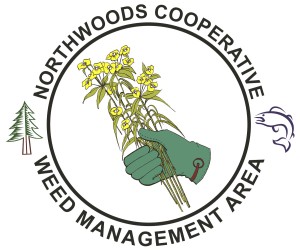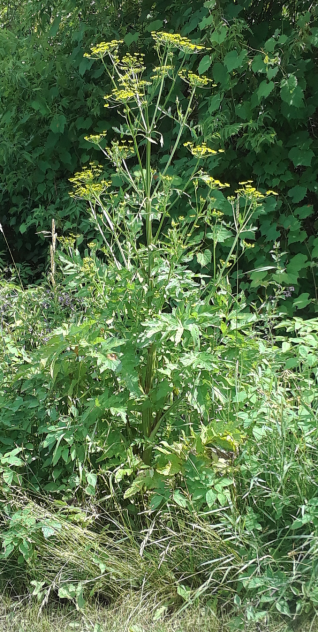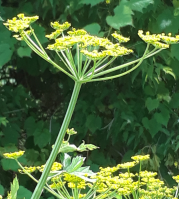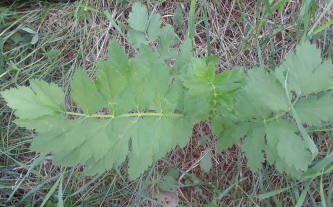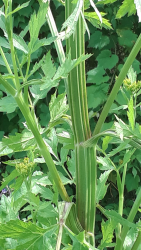Wild Parsnip (Pastinaca sativa)
Wild Parsnip (Pastinaca sativa) was brought to the United States as an edible root. It has since escaped cultivation and spread into disturbed open areas, especially along trails and roadsides. It can grow in a wide variety of moisture levels from wet to dry soils. Despite control efforts, it has been spreading quickly in the NCWMA region in recent years.
Controlling wild parsnip is a high priority for the NCWMA due to its human health risks. When its sap touches human skin followed by exposure to sunlight, the chemicals of the sap cause a painful rash or burn that may blister. This type of skin damage induced by sunlight is called phytophotodermatitis. The skin damage does not develop until a few days after exposure, so people may expose themselves repeatedly over a long period of time without realizing it. Severe blistering burns can last for months and has resulted in hospitalizations.
Wild parsnip has numerous small five-petaled, pale-yellow flowers that are organized in umbels on top and upper branches. Flowering plants can reach over five feet tall and have vertical grooves along the stem. The leaves are alternate along the stem and have five to fifteen toothed-leaflets that are pinnate (organized in pairs). It blooms from late June to mid-July. Typically plants flower during their second or third year. Non-flowering plants produce a low rosette of pinnate leaves (bottom-right photo). Plants flower once and then die after producing seeds. Seeds are viable in the soil for up to four years.
Wild parsnip typically spreads by seeds. To slow the spread of wild parsnip along roads and powerlines, plants should not be mowed after the seeds develop, which is typically after mid-July in northern Wisconsin. Small populations of wild parsnip can be controlled by hand-pulling or cutting through the root (1 or 2 inches below the ground). Large populations can be treated with herbicide such as metsulfuron or glyphosate. People working with wild parsnip or mowing areas that may have wild parsnip should wear long sleeves, long pants, and gloves to prevent skin exposure.
Sources: Czarapata, Elizabeth. 2005. Invasive Plants of the Upper Midwest. University of Wisconsin Press. Madison, WI. pp 70-72.
Panke, Brenden; deRegnier, Ryan; and Renz, Mark. 2012.Management of Invasive plants in Wisconsin: Wild parsnip (A3924-15). University of Wisconsin-Extension. 4 pp. Available at https://fyi.extension.wisc.edu/wifdn/learn/invasive-species-i-d-and-impacts/
Summary of Important Points about Wild Parsnip
- Monocarpic perrenial: Rosette stage for multiple years, then flowers once and dies.
- Leaves toothed and divided with egg shaped-leaflets along single stem (pinnate);
- Flowering plants grow to 4 ft high with alternate leaves.
- Tiny pale yellow flowers in flat top clusters (umbels)
- Can cause phytophotodermatitis: Sap on skin with sunlight can cause serious blisters.
- Spreads in openings, especially along roadsides.
Control Efforts
- Mow roadsides prior to seed development.
- Educate county and municipality of proper timing of mowing
- Spot treat plants with herbicide prior to seeding

